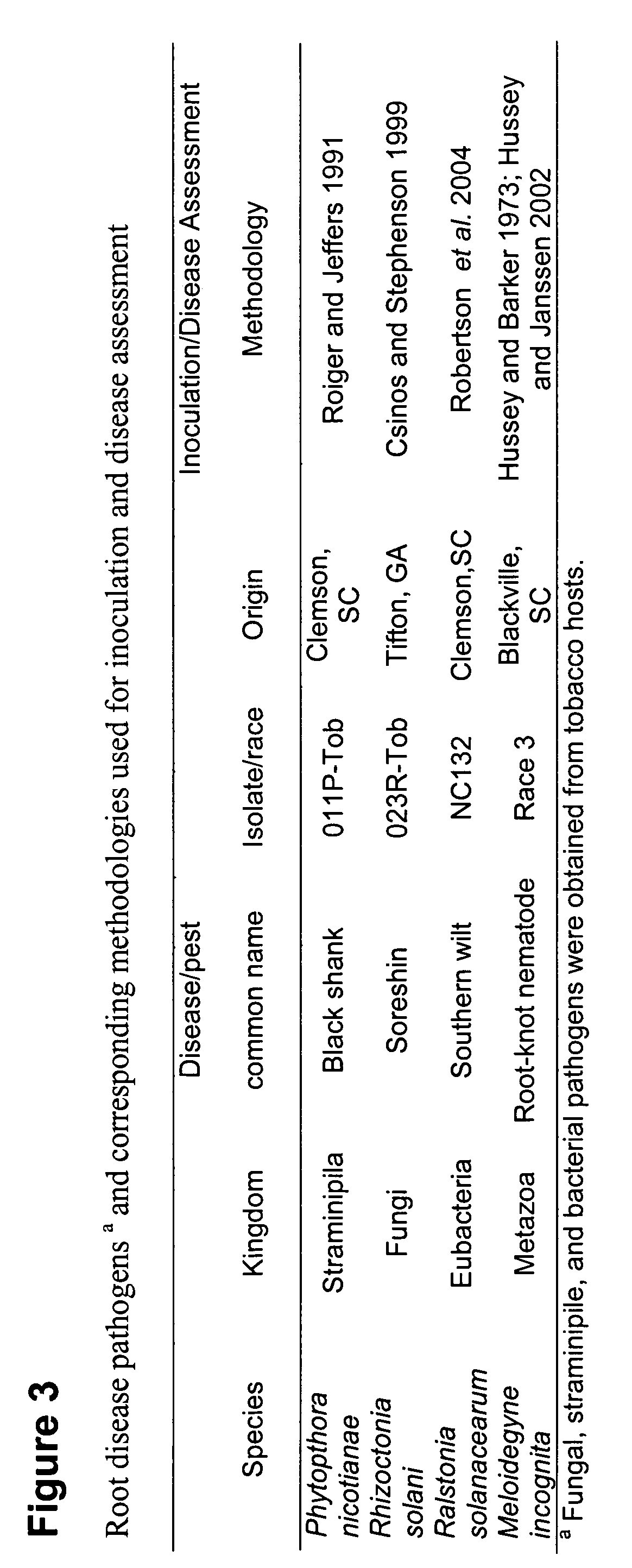Increased resistance of plants to pathogens from multiple higher-order phylogenetic lineages
a higher-order phylogenetic lineage and pathogen resistance technology, applied in the field of increased resistance of plants to pathogens from multiple higher-order phylogenetic lineages, can solve the problems of limited crop rotation value, inability to use many previously common fumigants such as methyl bromide, and limited current management options for such plant pathogens. , to achieve the effect of increasing the resistance of plants, and increasing the resistan
- Summary
- Abstract
- Description
- Claims
- Application Information
AI Technical Summary
Benefits of technology
Problems solved by technology
Method used
Image
Examples
example 1
[0060]E. coli strains containing gastrodianin isoforms VNF and VGM were obtained from the Laboratorium Genetica, Gent, Belgium. The part of the cDNA that encodes each mature isoform was translationally fused to the maltose-binding protein (MBP) in the vector pMal-p2 to produce fusion proteins in E coli according to the methods of Wang et al. (previously incorporated herein by reference). MBP-gastrodianin fusion proteins were produced according to the manufacturer's instructions (New England Biolabs). Essentially, log-phase cultures of E. coli were induced for fusion protein production for 2 hours by addition of isopropyl-beta-D-thiogalactopyranoside (0.1 mM). Cells were harvested by centrifugation and the secreted MBP-fusion proteins were isolated from the periplasmic fraction by cold osmotic shock. After affinity chromatography on an amylose resin, the fusion proteins were recovered in elution buffer (20 mM Tris-HCL, pH 7.4, 200 mM NaCl, 1 mM EDTA, 10 mM maltose) and stored at −20°...
example 2
[0064]A. tumefaciens strain EHA 101 containing pAVNFbin or pAVAT formed as described in Example 1 was used to transform tobacco (cv. Wisconsin 38) using a modified Agrobacterium cocultivation method (Burow, D. M., et al., Plant Mol. Biol. Rep., 8, (1990) 124-139). Prior to transformation A. tumefaciens colonies were streaked out onto agarose Luria Broth agar amended with 50 mg / l kanamycin and 150 mg / l spectinamycin for selection and grown at 28° C. for 2 days in the dark. During co-cultivation, tobacco leaf tissue was sliced into approximately 3 cm square segments and punctured lightly with a scalpel to facilitate infection by A. tumefaciens. Generous amounts of transformed A. tumefaciens cells containing one of two plasmids, pAVNFbin or pAVAT, were smeared onto the leaf segments, and immediately placed onto co-cultivation media for 6 days at 28° C. After co-cultivation, inoculated plant tissue was placed on selection media with 100 mg / l kanamycin for selection and 500 mg / l carbenic...
example 3
[0079]A. tumefaciens strain EHA 101 containing pAVNFbin or pAVAT formed as described in Example 1 was used to transform plum.
[0080]Plum seeds were collected from mature fruit. The flesh was removed from the endocarp (stone), cleaned and allowed to air dry 2-3 days at room temperature. Prior to use, the endocarp was removed with a nutcracker, seeds were surface-sterilized and soaked in sterile water overnight at room temperature. Subsequently, seed coats were removed. The radicle and the epicotyl were discarded and the hypocotyl mid-section sliced into cross sections (0.5-1 mm), which were used for regeneration / transformation.
[0081]Transformation / regeneration. Hypocotyl slices were immersed in resuspended A. tumefaciens for 10-20 min, blotted briefly on sterile filter paper and placed on cocultivation medium, SRM (shoot regeneration medium) without antibiotics. After two days the explants were washed in 1 / 2 strength MS (Mureshige and Skoog) medium with 300 mg / l timentin, blotted brie...
PUM
| Property | Measurement | Unit |
|---|---|---|
| diameter | aaaaa | aaaaa |
| temperature | aaaaa | aaaaa |
| total volume | aaaaa | aaaaa |
Abstract
Description
Claims
Application Information
 Login to View More
Login to View More - R&D
- Intellectual Property
- Life Sciences
- Materials
- Tech Scout
- Unparalleled Data Quality
- Higher Quality Content
- 60% Fewer Hallucinations
Browse by: Latest US Patents, China's latest patents, Technical Efficacy Thesaurus, Application Domain, Technology Topic, Popular Technical Reports.
© 2025 PatSnap. All rights reserved.Legal|Privacy policy|Modern Slavery Act Transparency Statement|Sitemap|About US| Contact US: help@patsnap.com



